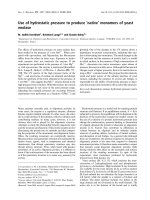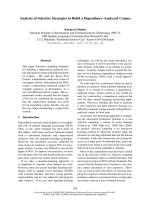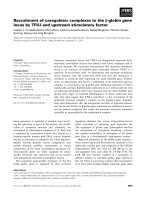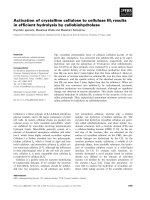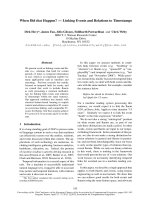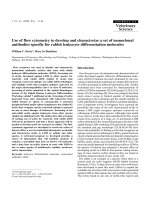Báo cáo khoa học: " Efficacy of and tolerance to mild induced hypothermia after out-of-hospital cardiac arrest using an endovascular cooling system" pptx
Bạn đang xem bản rút gọn của tài liệu. Xem và tải ngay bản đầy đủ của tài liệu tại đây (234.71 KB, 8 trang )
Open Access
Available online />Page 1 of 8
(page number not for citation purposes)
Vol 11 No 3
Research
Efficacy of and tolerance to mild induced hypothermia after
out-of-hospital cardiac arrest using an endovascular cooling
system
Nicolas Pichon
1
, Jean Bernard Amiel
1
, Bruno François
1
, Anthony Dugard
1
, Caroline Etchecopar
2
and Philippe Vignon
1
1
Intensive Care Unit, Dupuytren University Hospital, 2 Avenue Martin Luther King, 87000, Limoges, France
2
Department of Cardiology, Dupuytren University Hospital, 2 Avenue Martin Luther King, 87000, Limoges, France
Corresponding author: Nicolas Pichon,
Received: 30 Jan 2007 Revisions requested: 10 Apr 2007 Revisions received: 22 May 2007 Accepted: 28 Jun 2007 Published: 28 Jun 2007
Critical Care 2007, 11:R71 (doi:10.1186/cc5956)
This article is online at: />© 2007 Pichon et al.; licensee BioMed Central Ltd.
This is an open access article distributed under the terms of the Creative Commons Attribution License ( />),
which permits unrestricted use, distribution, and reproduction in any medium, provided the original work is properly cited.
Abstract
Introduction We evaluated the efficacy of and tolerance to mild
therapeutic hypothermia achieved using an endovascular
cooling system, and its ability to reach and maintain a target
temperature of 33°C after cardiac arrest.
Methods This study was conducted in the medical-surgical
intensive care unit of an urban university hospital. Forty patients
admitted to the intensive care unit following out-of-hospital
cardiac arrest underwent mild induced hypothermia (MIH). Core
temperature was monitored continuously for five days using a
Foley catheter equipped with a temperature sensor. Any
equipment malfunction was noted and all adverse events
attributable to MIH were recorded. Neurological status was
evaluated daily using the Pittsburgh Cerebral Performance
Category (CPC). We also recorded the mechanism of cardiac
arrest, the Simplified Acute Physiologic Score II on admission,
standard biological variables, and the estimated time of anoxia.
Nosocomial infections during and after MIH until day 28 were
recorded.
Results Six patients (15%) died during hypothermia. Among the
34 patients who completed the period of MIH, hypothermia was
steadily maintained in 31 patients (91%). Post-rewarming
'rebound hyperthermia', defined as a temperature of 38.5°C or
greater, was observed in 25 patients (74%) during the first 24
hours after cessation of MIH. Infectious complications were
observed in 18 patients (45%), but no patient developed severe
sepsis or septic shock. The biological changes that occurred
during MIH manifested principally as hypokalaemia (< 3.5 mmol/
l; in 75% of patients).
Conclusion The intravascular cooling system is effective, safe
and allows a target temperature to be reached fairly rapidly and
steadily over a period of 36 hours.
Introduction
Mild induced hypothermia (MIH) was recently shown to
improve neurological outcomes in patients who had sustained
post-resuscitation encephalopathy secondary to cardiac
arrest [1-3]. Accordingly, this procedure has been recom-
mended as part of the standard of care for out-of-hospital car-
diac arrest [4]. Nevertheless, the optimal technique for
achieving MIH and its benefit/risk ratio in the target population
remain controversial [5]. Conventional techniques for effecting
therapeutic hypothermia are cumbersome and time consum-
ing, or they do not allow precise control of body temperature
[6]. Accordingly, we assessed the efficacy of and tolerance to
a recently available endovascular cooling system in patients
who were successfully resuscitated following out-of-hospital
cardiac arrest.
Materials and methods
All studied patients underwent MIH as part of their initial man-
agement using the CoolGard™ Thermal Regulation System
(Alsius Corporation, Irvine, CA 92618, USA) connected to a
balloon-equipped endovascular Icy™ catheter (Alsius Corp.)
(single perfusion line with cooled normal saline) designed to
be inserted in the inferior vena cava via the femoral vein. The
decision regarding whether perform MIH was left to the
ACLS = advanced cardiac life support; CPC = Pittsburgh Cerebral Performance Category; MIH = mild induced hypothermia.
Critical Care Vol 11 No 3 Pichon et al.
Page 2 of 8
(page number not for citation purposes)
discretion of the attending physician. Exclusion criteria were
age above 85 years, a Glasgow Coma Scale score above 7 on
admission, an in-hospital cardiac arrest, an estimated time of
anoxia in excess of 40 min, and time from initiation of advanced
cardiac life support (ACLS) to recovery of spontaneous circu-
lation greater than 60 min. Because this observational study
did not alter the standard of care in resuscitated patients after
cardiac arrest in our institution, no informed consent was
required.
Cooling system
The femoral catheter was 35 cm long with three inserted cylin-
drical balloons, which were filled with serum saline and con-
nected to a bedside refrigerator designed to reach and
maintain a target temperature set by the operator (Figure 1).
Normal saline temperature in the cooling system was automat-
ically adjusted according to the patient's core temperature,
which was monitored using a temperature-sensing thermistor
bladder catheter, and the target temperature and the desired
rate of cooling (ranging from 0.1°C/hour to 0.7°C/hour) set by
the operator.
Mild induced hypothermia
No prehospital hypothermia was induced and the MIH proce-
dure was initiated as soon as possible after the patient was
admitted to the emergency room. The target temperature was
usually 33°C, and a maximal cooling rate was typically chosen.
Once the target temperature was obtained, MIH was usually
maintained for 36 hours. The core temperature was subse-
quently increased at a rate of 0.3°C/hour using the cooling
system.
Patient management
ACLS was performed according to standard guidelines [7].
Efforts were made to use the 'Utstein' style for reviewing,
reporting and conducting research on post-resuscutation care
[8,9]. All patients were intubated endotracheally in the field
and were mechanically ventilated by the prehospital medical
team. Central venous lines, including the femoral catheter,
were inserted by the intensivist, who was on call in the emer-
gency room on admission. No radiological assessment was
performed to check that the tip of the catheter was positioned
within the inferior vena cava. Patients received routine acute
clinical care, including monitoring of vital signs. Whether emer-
gency coronarography should be performed was left to the
discretion of the cardiologist and intensivist in charge of the
patient. When angioplasty was performed, routine anti-aggre-
gant treatment associated with unfractioned heparin was
administered. MIH was interrupted only during patient trans-
portation to the coronarography room, and it was resumed
during the revascularization procedure. Patients were sedated
with a continuous midazolam infusion, and pancuronium bro-
mide was administered when necessary to avoid shivering dur-
ing MIH.
End-points
The primary end-point was the ability of the endovascular cool-
ing system to achive a preset target temperature and to main-
tain a steady MIH of 33°C for 36 hours, which was empirically
defined as variations in core temperature of less than 0.4°C.
Secondary objectives were to describe expected side effects
that had previously been attributed in the literature to MIH or
to the cooling system; to assess spontaneous core tempera-
ture variations after cessation of MIH; and to evaluate patient
neurological outcome, as assessed using the Pittsburgh Cer-
ebral Performance Category (CPC) on day 28 [1,10,11].
Data collection
Core temperature was monitored continuously for five days
and recorded every two hours during the first 12 hours, every
six hours for the next three days, and twice a day for the
remaining days. A Foley catheter equipped with a temperature
sensor CURITY
®
(Degania Silicone Ltd, Degania Bet, Israel)
was used to monitor core temperature (range of measured
temperature: 0°C to 50°C, with an accuracy of ± 0.1°C
between 25°C and 45°C). The time of initiation of ACLS was
defined as T
0
. Any equipment malfunction was noted and all
adverse events attributable to MIH were recorded during
hypothermia and until core temperature reached 37°C after
rewarming.
In each patient, neurological status was evaluated daily until
hospital discharge or death, or on day 28, whichever occurred
first, by phone call to the patient or their family. This evaluation
was performed by one independent physician, who had not
been involved in patient care, using the CPC, which is based
on the Glasgow Outcome Performance categories [8,12]. A
CPC score of 1 or 2 is consistent with a favorable neurological
outcome, whereas a CPC score of 3, 4, or 5 reflects a poor
neurological outcome or death.
Figure 1
Equipment usedEquipment used. (a) Inserted CoolGard™ Thermal Regulation System
with patient's temperature monitoring, and (b) balloon-equipped Icy™
femoral catheter used for endovascular cooling.
Available online />Page 3 of 8
(page number not for citation purposes)
We also recorded the mechanism of cardiac arrest (ventricular
fibrillation or tachycardia versus pulseless rhythms), Simplified
Acute Physiologic Score II on admission, standard biological
variables, and the estimated time of cerebral anoxia. The time
of onset of cardiac arrest was only recorded in cases of wit-
nessed cardiac arrest, and the estimated duration of cerebral
anoxia was defined as the interval from collapse (presumed
time of cardiac arrest) to first resuscitation attempt by emer-
gency medical services. Biological variables were recorded
every 12 hours for three days and once daily after. Because
variations in body temperature have an important impact on
the results of blood gas monitoring, algorithms were used to
correct arterial blood gases for MIH [13]. No particular infec-
tion control strategy was applied during MIH. Guidelines on
nosocomial infections were applied to define pneumonia, uri-
nary tract infection, or catheter-related septicemia [14]. Sys-
tematic ultrasound of the femoral veins was performed after
catheter removal to exclude potential development of deep
vein thrombosis.
Ethics committee
This study was approved by the Association des Réanima-
teurs du Centre-Ouest ethics committee, which waived the
need for informed consent.
Statistical analysis
Continuous variables are expressed as mean ± standard devi-
ation. Categorical variables are reported as number (percent-
age). Mann-Whitney U test was used to compare continuous
variables and χ
2
test (or Fischer's exact test when necessary)
was used to compare categorical variables between subsets
of patients with favorable and poor neurological outcomes. P
< 0.05 was considered statistically significant.
Results
Over a two-year period, 81 patients were admitted to the
intensive care unit of our institution for management of resus-
citated cardiac arrest. Among them, 10 patients (12%) sus-
tained in-hospital cardiac arrest and were excluded. Among
the 71 patients who sustained an out-of-hospital cardiac
arrest, 31 patients (44%) had at least one exclusion criterion.
The remaining 40 patients underwent MIH and constituted the
study population.
Cardiac arrest was considered to be of cardiac origin in 31
patients (78%) and was deemed hypoxic in the nine remaining
patients (three drownings, four hangings and two penetrative
injuries). Among the 31 patients, the initial rhythm was ven-
tricular fibrillation in 14, asystole in 23 and pulseless electric
activity in the remaining three. Emergency angioplasty was
performed in nine patients (23%), after initiation of MIH. The
patients' characteristics are summarized in Table 1.
Mean interval between ACLS and initiation of MIH was 98 ±
54 min (range 45 to 300 min), and the target core temperature
was reached after a mean interval of 296 ± 148 min (range
110 to 805 min) after cardiac arrest. Catheters were inserted
successfully in all cases. The target temperature of 33°C was
achieved after a mean period of 187 ± 119 min (range 30 to
600 min) after initiation of MIH (Table 1). In one patient, the
intervals between cardiac arrest and initiation of MIH and
between initiation of MIH and stabilization at the target temper-
ature were 205 min and 600 min, respectively. This patient
exhibited a relatively high body temperature on admission
(37°7C), partly related to refractory myoclonus, and did not
receive paralysis treatment. Once the target temperature was
achieved, active cooling was performed for 37 ± 6 hours
(range 20 to 48 hours).
Six patients (15%) died (four from cardiogenic shock and two
from cerebral death) during MIH. Cardiac dysrythmia was
observed in 11 patients (28%) during hypothermia, but this
appeared to be unrelated to MIH. Dysrythmia consisted of ven-
tricular fibrillation in two patients (who underwent defibrilla-
tion) and atrial fibrillation in the remaining nine patients (who
received intravenous amiodarone, associated with correction
of hypokalaemia in five of them).
Pancuronium bromide was administered to 19 patients (48%)
to avoid excessive shivering during MIH. Among the 34
patients who completed the 36-hour period of MIH, hypother-
mia was maintained steadily in 31 patients (91%), with a core
temperature maintained between 32.6°C and 33.4°C (Figure
2). In the three remaining patients, maximal temperature varia-
tions recorded around the target temperature were 1°C, 1.5°C
and 2.6°C.
Once progressive rewarming was initiated, normothermia was
achieved after a mean of 808 ± 365 min (range 420 to 1,800
min), close to the expected 800 min necessary at a warming
rate of 0.3°C/hour. Post-rewarming 'rebound hyperthermia',
Figure 2
Evolution of core temperature during MIH and rewarming in the study populationEvolution of core temperature during MIH and rewarming in the study
population. MIH, mild induced hypothermia.
Critical Care Vol 11 No 3 Pichon et al.
Page 4 of 8
(page number not for citation purposes)
defined as temperature of 38.5°C or greater, was observed in
25 patients (74%) during the first 24 hours that followed ces-
sation of MIH (Figure 2). Catheters were withdrawn during the
24 hours following the end of MIH. None of the catheters were
found to be colonized. No deep venous (particularly femoral)
thrombosis was diagnosed both clinically and with routine
ultrasound at the time of catheter removal.
Only few complications attributable to MIH were observed
(Table 2). Haemorrhagic complications consisted mainly of
nonserious bleeding related to the venous catheter insertion,
which did not require blood transfusion. A single case of trau-
matic false aneurysm formation secondary to accidental punc-
ture of a femoral artery was encountered (Table 2). Infectious
complications were observed in 18 patients (45%), but no
patient developed severe sepsis or septic shock. Five patients
developed a nosocomial bacteraemia (Staphylococcus
aureus in four cases), five patients (13%) were diagnosed with
an early-onset nosocomial pneumonia (occurring within 72
hours after tracheal intubation; Table 2), six patients were
diagnosed with an early-onset nosocomial bronchitis, and two
patients were diagnosed with an urinary tract infection. During
the study period, rates of infection in patients who did not
undergo MIH in our intensive care unit were 12% for nosoco-
mial pneumonia, 14% for bronchitis, 7% for nosocomial
urinary tract infections and 2% for nosocomial bacteraemia.
There was no apparent relationship between these docu-
mented bacterial infections during MIH and post rewarming
'rebound hyperthermia'.
Biological pancreatitis and seizures were not observed. When
compared with baseline values obtained on admission, MIH
presumably resulted in mild biological changes, with the
exception of relevant hypokalaemia; 28% of patients had a
potassium level below 3.5 mmol/l on admission, whereas this
proportion reached 77% after 24 hours of MIH. Consequently,
the mean potassium level significantly decreased after 24
hours of MIH compared with baseline (3.2 ± 0.6 mmol/l [range
2.2 to 4.6 mmol/l] versus 4.1 ± 0.8 mmol/l [range 2.8 to 6.6
mmol/l]; P < 0.0001). During the initial course of hypothermia,
potassium was monitored closely and maintained within the
normal range.
Among the 27 patients (67%) with a poor outcome, 24
patients died during their hospitalization (six patients during
MIH and 18 patients after a decision to withdraw acute care)
and three patients had moderate or severe neuromotor disabil-
ity at hospital discharge. The remaining 13 out of the 40
patients had a favorable neurological outcome, with a CPC
score of either 1 (n = 8) or 2 (n = 5) on day 28. Overall, 57%
of patients who sustained a ventricular fibrillation, 17% of
patients with asystole and 33% of patients with other pulse-
Table 1
Characteristics of the study population at baseline and outcome
Characteristic All patients (n = 40) Outcome
a
Good (n = 13) Poor (n = 27) P value
Mean age (years) 58 ± 14 53 ± 17 (15 to 76) 61 ± 12 (30 to 81) 0.12
SAPS II score 61 ± 19 49 ± 18 (13 to 75) 66 ± 17 (41 to 125) 0.01
Men (n) 31/40 8/13 (62%) 23/27 (85%) 0.23
Ventricular fibrillation 14 8 (57%) 6 (43%)
Asystole 23 4 (17%) 19 (83%)
Other pulseless electric activity 3 1 (33%) 2 (67%)
Temperature on admission to the emergency
department (°C)
36 ± 1 36.1 ± 1.1 (33.8 to 38) 35.9 ± 1.1 (33.6 to 37.7) 0.86
Glasgow Coma Scale score 4 ± 1 4 ± 2 (3 to 7) 3 ± 1 (3 to 7) 0.20
Glucose on admission (mmol/l) 13.6 ± 5 14.6 ± 4.9 (9 to 24.4) 13.1 ± 5.1 (2.6 to 22.2) 0.55
Lactates on admission (mmol/l) 9.8 ± 6.4 8.4 ± 5.8 (2.3 to 19.1) 10.5 ± 6.6 (2.4 to 24.8) 0.20
Arterial pH on admission 7.25 ± 0.18 7.25 ± 0.15 (6.93 to 7.45) 7.25 ± 0.19 (6.84 to 7.54) 0.55
Estimated time of anoxia (min) 11 ± 9 7 ± 4 (0 to 14) 13 ± 9 (1 to 40) 0.03
Time from initiation of ACLS to ROSC (min) 16 ± 10 21 ± 12 (1 to 45) 14 ± 8 (1 to 35) 0.06
Time from ACLS to initiation of MIH (min) 98 ± 54 103 ± 50 (45 to 190) 96 ± 57 (55 to 300) 0.51
Time from initiation of MIH to achieving goal
temperature (min)
187 ± 119 198 ± 88 (30 to 360) 181 ± 132 (30 to 600) 0.25
Values are expressed as mean ± standard deviation.
a
Good outcome corresponded to CPC scores of 1 or 2; poor outcome corresponded to CPC
scores of 3 to 5. ACLS, advanced cardiac life support; CA, cardiac arrest; MIH, mild induced hypothermia; ROSC, return of spontaneous
circulation; SAPS, Simplified Acute Physiology Score.
Available online />Page 5 of 8
(page number not for citation purposes)
less electric activity had a favorable outcome. The estimated
time of anoxia was shorter in the subset of patients with favo-
rable outcome (7 ± 4 min versus 13 ± 9 min; P = 0.03). The
time between initiation of ACLS and return of spontaneous cir-
culation and the time between ACLS and initiation of MIH
were similar between groups (Table 1). Similarly, the period
required to achieve the target core temperature was similar
between study groups (Table 1). MIH-attributed complications
were equally distributed between patient groups (Table 2).
Discussion
MIH is increasingly being used to provide protection for the
brain against post-ischaemic injury [15]. In various clinical cir-
cumstances, such as resuscitation following cardiac arrest,
MIH may improve neurologic outcome when it is initiated
quickly enough [1-4]. Clinical studies evaluating both the effi-
cacy of and tolerance to recently available endovascular cool-
ing systems are scarce [16].
The present study showed that the CoolGard™ Thermal Reg-
ulation System, connected to an Icy™ catheter inserted in the
femoral vein, allowed the target temperature of 33°C to be
attainted after a mean of 187 min (Table 1). This intravascular
cooling system appeared to induce hypothermia faster than
external devices, because a similar target temperature was
obtained after means of 480, 301 and 287 min using external
cooling techniques (cold air mattress, ice packs and cooling
blankets, respectively) [1,10,17]. External cooling systems
usually allow body temperature to be decreased at a rate of
0.3 to 0.5°C/hour [18], whereas the endovascular device used
in our patients induced hypothermia at a mean rate of 1.1 ±
0.4°C/hour without use of additional external device. Paralytic
drug therapy, frequently used in our patients, presumably
accelerated the cooling rate by avoiding excessive shivering.
Using the same endovascular cooling device, Georgiadis and
coworkers [19] recently reported a mean cooling rate of 1.4 ±
0.6°C/hour. In keeping with previous reports, the present
study suggests that intravascular cooling systems allow induc-
tion of moderate hypothermia more rapidly than various exter-
nal techniques.
Because the protective effects of MIH appear to be greater
when it is initiated early [20], investigators have recently pro-
posed that ice cold intravenous fluid be administered to
reduce the time needed to reach the target temperature
[3,6,21]. In 22 patients who sustained an out-of-hospital car-
diac arrest, Bernard and coworkers [3] lowered body temper-
ature by 1.6°C over 25 min by rapidly infusing 30 ml/kg of
crystalloid at 4°C, without noticeable adverse effect. Similarly,
Polderman and coworkers [6] recently reported mean
decreases in core temperature of 2.3°C and 4.0°C over 30
min and 60 min, respectively, in 134 patients undergoing MIH.
Although more rapid than the endovascular device evaluated
in the present study, rapid infusion of refrigerated saline does
not allow one to maintain induced hypothermia steadily at the
predefined target temperature. Accordingly, this approach
appears to be a promising additional means to induce hypo-
thermia rapidly, but it should be combined with another system
once the target temperature has been reached [6].
In the present study, the target temperature of 33°C was
reached in all patients and maintained steadily over a mean of
36 hours in all but three patients (91%). In contrast, external
cooling systems such as cooling blankets, ice packs, cold lav-
age, or cooling helmet failed to achieve the target temperature
in a substantial proportion of patients in whom MIH was indi-
cated [1,10,17]. In a landmark clinical study, Holzer and cow-
orkers [1] reported that external cooling using packs of ice
allowed attainment of the target temperature of 33°C in only
30% of patients hospitalized after cardiac arrest. Furthermore,
Table 2
Complications observed during MIH and 5 days after rewarming and patients' outcome
Adverse effects Complications (n [%]) Outcome
a
Good (n = 13) Poor (n = 27)
Bleeding of any severity 3 (8%) 1 (8%) 2 (8%)
Need for packed RBC transfusions 4 (10%) 2 (16%) 2 (8%)
Complication on catheter site
b
3 (8%) 1 (8%) 2 (8%)
Hypokalaemia (< 3.5 mmol/l) 30 (75%) 10 (77%) 20 (74%)
Nosocomial infection (MIH/non-MIH)
c
Septicemia 5 (13%)/2%
c
2 (16%) 3 (11%)
Urinary tract infection 2 (5%)/7%
c
2 (16%) 0
Pneumonia 5 (13%)/12%
c
2 (16%) 3 (11%)
Bronchitis 6 (15%)/14%
c
2 (16%) 4 (15%)
a
Good outcome corresponded to CPC scores of 1 or 2; poor outcome corresponded to CPC scores of 3 to 5.
b
Included are haematoma, local
haemorrhage and false aneurysm formation.
c
This percentage is the rate of infection in patients who did not undergo MIH in our intensive care unit
during the study period. MIH, mild induced hypothermia; RBC, red blood cells.
Critical Care Vol 11 No 3 Pichon et al.
Page 6 of 8
(page number not for citation purposes)
with regard to temperature variation with time, MIH was fairly
stable over time (37 ± 6 hours) in our patients (Figure 2),
whereas core temperature was found to be less stable in stud-
ies using external cooling techniques [1,10,17].
Although slow rewarming is widely advocated, because rapid
increase in body temperature after MIH may offset its potential
beneficial effects on brain injury [11], no precise recommenda-
tion is currently available regarding the optimal rewarming
technique [4]. In 74% of our patients, we observed an
increase in body temperature to 38.5°C or greater during the
first 24 hours that followed progressive rewarming (Figure 2).
This finding is in keeping with that reported by McIntyre and
coworkers [18], who observed 'rebound hyperthermia' result-
ing from rapid rewarming after MIH induced to manage severe
head trauma with associated brain oedema. Importantly, this
rebound hyperthermia was associated with an increase in
intracranial pressure. Brain oedema secondary to postanoxic
injury after a cardiac arrest may potentially be worsened by the
hyperthermia that was noted in a substantial proportion of our
patients after slow rewarming. This phenomenon frequently
observed after rewarming has not yet been clearly explained,
and may be secondary to sustained cytokine release related to
ischaemia/reperfusion cerebral injuries. In the present study,
prolonged use of the cooling system (with a target tempera-
ture of 37°C) appears to be an effective approach to avoiding
post-rewarming rebound hyperthermia in patients who under-
went MIH after cardiac arrest. Nevertheless, efficacy of and
tolerance to such prolonged use of this external cooling sys-
tem require further study.
The present study showed that early-onset nosocomial infec-
tions were the most frequent complication observed over
seven days after the initiation of MIH (Table 2). Comparison of
rates of nosocomial infections between patients who under-
went MIH and the remaining patients hospitalized in our inten-
sive care unit over the same period revealed an increased rate
of bacteraemia only (13% versus 2%). A significantly higher
rate of nosocomial pneumonia during therapeutic hypothermia
was reported only in one case-control study [22], but this find-
ing was not confirmed by our study (13% versus 12%).
Hypokalaemia was observed in the majority of our patients, but
this was not associated with relevant arrhythmia (Table 2). A
nonsignificant increase in white blood cells was observed dur-
ing MIH (P = 0.02), whereas haemoglobin and platelet count
remained unchanged. In a recent meta-analysis [23], only one
clinical study identified a nonsignificant increase in haemor-
rhagic complications and sepsis in patients undergoing MIH
when compared with normothermic patients [1]. In our study,
no complication related to insertion of the 35 cm femoral cath-
eter was noted. Minor local complications such as bleeding at
the puncture site have previously been reported in fewer than
10% of cases [19,24].
The present observational study has several limitations. In the
absence of randomization, the potential benefits of MIH in
terms of neurological outcome cannot be evaluated in our
study population. Similarly, reported complications in our
patients cannot clearly be attributed to MIH. In addition, MIH
was maintained for a mean of 37 ± 6 hours, whereas the
International Liaison Committee on Resuscitation currently
recommends a period of 24 hours [4]. Nevertheless, the Com-
mittee emphasizes the fact that the optimum duration of hypo-
thermia remains to be determined [4] and the potential
benefits of applying MIH for longer than 24 hours require fur-
ther investigation [25]. Some of our patients who sustained a
hypoxic cardiac arrest with asystole also underwent MIH, but
they had a poor neurological outcome. According to the liter-
ature and the International Liaison Committee on Resuscita-
tion recommendations, patients suffering out-of-hospital
cardiac arrest secondary to asystole should not undergo MIH
[26]. Although MIH is currently recommended in witnessed
cardiac arrest secondary to ventricular fibrillation or tachycar-
dia [4], it may be performed in other categories of patients
regardless of initial rhythm, provided that the cardiac arrest is
witnessed and the prognosis is not hopeless because of
associated comorbidities [11]. Finally, physicians in charge of
resuscitated patients who have suffered cardiac arrest
recently reported fairly low rates of application of MIH [27].
Incorporation of current resuscitation guidelines for MIH and
future research aimed at improving cooling techniques may
improve physicians' awareness and utilization of therapeutic
hypothermia after out-of-hospital cardiac arrest [27-29].
Conclusion
The present study demonstrated that the CoolGard™ system
combined with the Icy™ venous catheter is efficient at inducing
MIH and well tolerated. This intravascular cooling system
allowed attainment of a target temperature of 33°C fairly rap-
idly and maintenance of MIH steadily over a period of 36 hours
in all patients. This system was also consistently effective at
progressive rewarming. Ease of use, efficacy and tolerance to
this cooling system justify further studies to evaluate modali-
ties for inducing MIH in various clinical settings, aiming to opti-
mize the protective effect against post-ischaemic and
traumatic brain injury. The efficacy and safety of prolonged use
of this endovascular cooling system to avoid post-rewarming
rebound hyperthermia remain to be investigated, as well as the
potential relation between MIH and early-onset nosocomial
infections.
Competing interests
The authors declare that they have no competing interests.
Authors' contributions
NP and JBA were responsible for the conception and design
of the study, acquisition and interpretation of data, and writing
of the manuscript. BF, AD and CE acquired data. PV was
responsible for reviewing and writing of the manuscript.
Available online />Page 7 of 8
(page number not for citation purposes)
References
1. The Hypothermia after Cardiac Arrest Study Group: Mild thera-
peutic hypothermia to improve the neurologic outcome after
cardiac arrest. N Engl J Med 2002, 346:549-556.
2. Hachimi-Idrissi S, Corne L, Ebinger G, Michotte Y, Huyghens L:
Mild hypothermia induced by a helmet device: a clinical feasi-
bility study. Resuscitation 2001, 51:275-281.
3. Bernard SA, Gray TW, Buist MD, Jones BM, Silvester W, Gut-
teridge G, Smith K: Treatment of comatose survivors of out-of-
hospital cardiac arrest with induced hypothermia. N Engl J
Med 2002, 346:557-663.
4. Nolan JP, Morley PT, Vanden Hoek TL, Hickey RW, Kloeck WG,
Billi J, Bottiger BW, International Liaison Committee on Resuscita-
tion: Therapeutic hypothermia after cardiac arrest: an advisory
statement by the advanced life support task force of the Inter-
national Liaison Committee on Resuscitation. Circulation
2003, 108:118-121.
5. Williamson JP, Illing R, Gertler P, Brande S: Near-drowning
treated with therapeutic hypothermia. Med J Aust 2004,
181:500-501.
6. Polderman KH, Rijnsburger ER, Peerdeman SM, Girbes ARJ:
Induction of hypothermia in patients with various types of neu-
rologic injury with use of large volumes of ice-cold intravenous
fluid. Crit Care Med 2005, 33:2744-2751.
7. Kramer-Johansen J, Wik L, Steen PA: Advanced cardiac life sup-
port before and after tracheal intubation: direct measurements
of quality. Resuscitation 2006, 68:61-69.
8. Cummins RO, Chamberlain DA, Abramson NS, Allen M, Baskett
PJ, Becker L, Bossaert L, Delooz HH, Dick WF, Eisenberg MS, et
al.: Recommended guidelines for uniform reporting of data
from out-of-hospital cardiac arrest: the Utstein Style. A state-
ment for health professionals from a task force of the Ameri-
can Heart Association, the European Resuscitation Council,
the Heart and Stroke Foundation of Canada, and the Austral-
ian Resuscitation Council. Circulation 1991, 84:960-975.
9. Langhelle A, Nolan J, Herlitz J, Castren M, Wenzel V, Soreide E,
Engdahl J, Steen PA, on behalf of the participants at the 2003
Utstein Consensus Symposium: Glutamate release and free
radical production following brain injury: effects of post-trau-
matic hyothermia. Resuscitation 2005, 66:271-283.
10. Zeiner A, Holzer M, Sterz F, Behringer W, Schorkhuber W, Mullner
M, Frass M, Siostrzonek P, Ratheiser K, Aff A, et al.: Mild resusci-
tative hypothermia to improve neurological outcome after car-
diac arrest. A clinical feasibility trial. Hypothermia After
Cardiac Arrest (HACA) Study Group. Stroke 2000, 31:86-94.
11. Polderman KH: Application of therapeutic hypothermia in the
intensive care unit. Opportunities and pitfalls of a promising
treatment modality - Part 2: Practical aspects and side effects.
Intensive Care Med 2004, 30:757-769.
12. Jennett B, Bond M: Assessment of outcome after severe brain
damage: a practical scale. Lancet 1975, 1:480-484.
13. Bacher A: Effects of body temperature on blood gases. Inten-
sive Care Med 2005, 31:24-27.
14. Nottebart HC Jr: The CDC guidelines for prevention and control
of nosocomial infections: view from the trenches. Am J Infect
Control 1985, 13:40-44.
15. Polderman KH: Application of therapeutic hypothermia in the
ICU: opportunities and pitfalls of a promising treatment
modality. Part 1: Indications and evidence. Intensive Care Med
2004, 30:556-575.
16. Holzer M, Mullner M, Sterz F, Robak O, Kliegel A, Losert H, Sodeck
G, Uray T, Zeiner A, Laggner AN: Efficacy and safety of endovas-
cular cooling after cardiac arrest: cohort study and Bayesian
approach. Stroke 2006, 37:1792-1797.
17. Felberg RA, Krieger DW, Chuang R, Persse DE, Burgin WS, Hick-
enbottom SL, Morgenstem LB, Rosales O, Grotta JC: Hypother-
mia after cardiac arrest: feasibility and safety of an external
cooling protocol. Circulation 2001, 104:1799-1804.
18. McIntyre LA, Fergusson DA, Hebert PC, Moher D, Hutchinson JS:
Prolonged therapeutic hypothermia after traumatic brain
injury in adults: a systematic review. JAMA 2003,
289:2992-2999.
19. Georgiadis D, Schwarz S, Kollmar R, Schwab S: Endovascular
cooling for moderate hypothermia in patients with acute
stroke: first results of a novel approach. Stroke 2001,
32:2550-2553.
20. Nozari A, Safar P, Stezoski W, Wu X, Kostelnik S, Radovsky A,
Tisherman S, Kochanek PM: Critical time window for intra-arrest
cooling with cold saline flush in a dog model of cardiopulmo-
nary resuscitation. Circulation 2006, 113:2690-2696.
21. Kliegel A, Losert H, Sterz F, Kliegel M, Holzer M, Uray T, Domano-
vitz H: Cold simple intravenous infusions preceding special
endovascular cooling for faster induction of mild hypothermia
after cardiac arrest – a feasibility study. Resuscitation 2005,
64:347-351.
22. Yanagawa Y, Ishihara S, Norio H, Takino M, Kawakami M, Takasu
A, Okamoto K, Kaneko N, Terai C, Okada Y: Preliminary clinical
outcome study of mild resuscitative hypothermia after out-of-
hospital cardiopulmonary arrest. Resuscitation 1998,
39:61-66.
23. Holzer M, Bernard SA, Hachimi-Idrissi S, Roine RO, Sterz F, Mull-
ner M, on behalf of the Collaborative Group on Induced Hypother-
mia for Neuroprotection After Cardiac Arrest: Hypothermia for
neuroprotection after cardiac arrest: systematic review and
individual patient data meta-analysis. Crit Care Med 2005,
33:414-418.
24. Doufas AG, Akca O, Barry A, Petrusca DA, Suleman MI, Morioka
N, Guarnaschelli JJ, Sessler DI: Initial experience with a novel
heat-exchanging catheter in neurosurgical patients. Anesth
Analg 2002, 95:1752-1756.
25. Globus MY, Alonso O, Dietrich WD, Busto R, Ginsberg MD:
Glutamate release and free radical production following brain
injury: effects of post-traumatic hyothermia. J Neurochem
1995, 65:1704-1711.
26. Oddo M, Schaller MD, Feihl F, Ribordy V, Liaudet L: From evi-
dence toclinical practice: Effective implementation of thera-
peutic hypothermia to improve patient outcome after cardiac
arrest. Crit Care Med 2006, 34:1865-1873.
27. Al-Senani FM, Graffagnino C, Grotta JC, Saiki R, Wood D, Chung
W, Palmer G, Collins KA: A prospective, multicenter pilot study
to evaluate the feasibility and safety of using the CoolGard
System and Icy catheter following cardiac arrest. Resuscitation
2004, 62:143-150.
28. Wolfrum S, Radke PW, Pischon T, Willich SN, Schunkert H,
Kurowski V: Mild therapeutic hypothermia after cardiac arrest:
a nationwide survey on the implementation of the ILCOR
guidelines in German intensive care units. Resuscitation 2007,
72:207-213.
29. Merchant RM, Soar J, Skrifvars MB, Silfvast T, Edelson DP, Ahmad
F, Huang KN, Kan M, Vanden Hoek TL, Becker LB, et al.
: Thera-
Key messages
• The Alsius CoolGard™ intravascular cooling system
combined with the Icy™ venous catheter is a safe, effi-
cient and well tolerated method for inducing MIH.
• This intravascular cooling system appears to be more
efficient than conventional external cooling methods in
tightly regulating body temperature (induction and sta-
bility of mild therapeutic hypothermia, as well as its
reversal).
• The safety and efficiency of prolonged use (> 24 hours)
of the present cooling system remain to be determined
by further studies.
• The potential relation between mild therapeutic hypo-
thermia and early-onset nosocomial infection remains to
be investigated, especially regarding the development
of bacteraemia.
• Incorporation of therapeutic hypothermia into resuscita-
tion guidelines may increase physicians' awareness and
yield improvements in the use of cooling systems in
resuscitated patients after cardiac arrest.
Critical Care Vol 11 No 3 Pichon et al.
Page 8 of 8
(page number not for citation purposes)
peutic hypothermia utilization among physicians after resusci-
tation from cardiac arrest. Crit Care Med 2006, 34:1935-1940.
